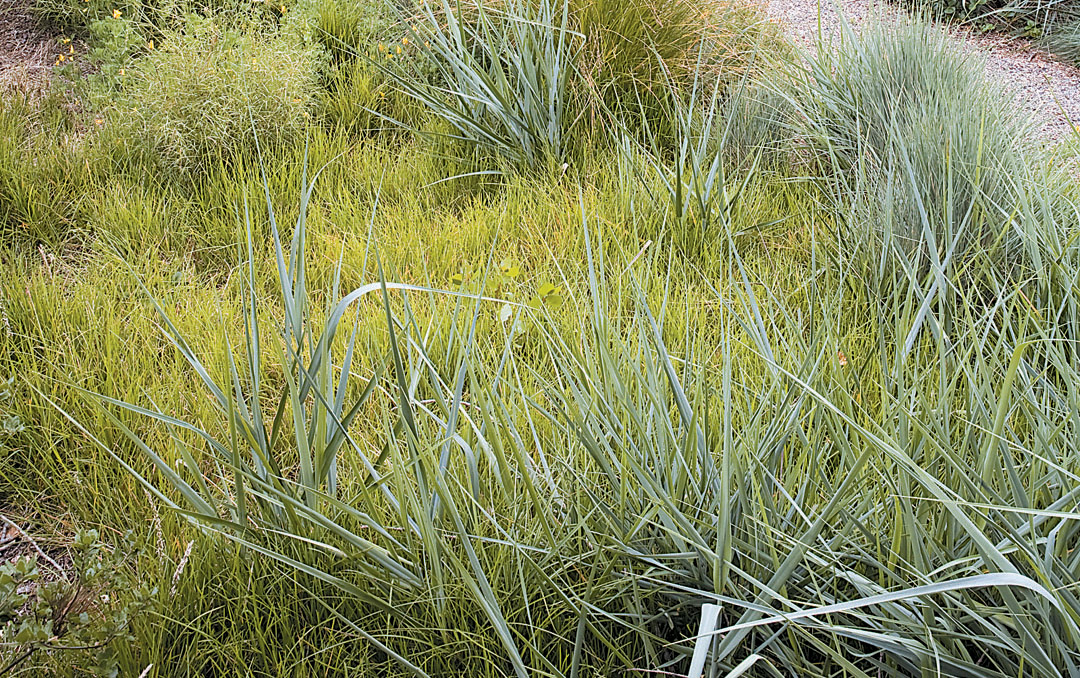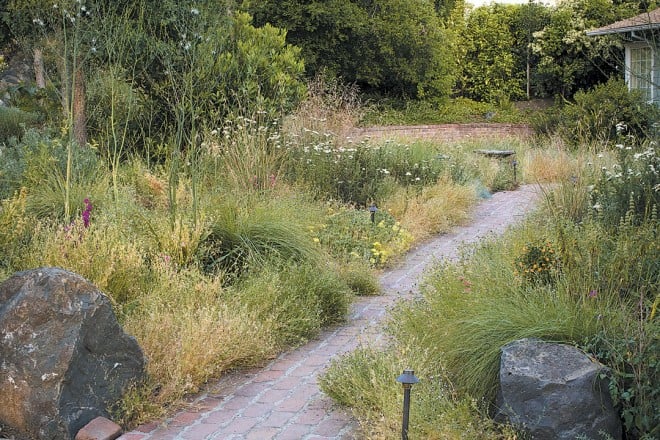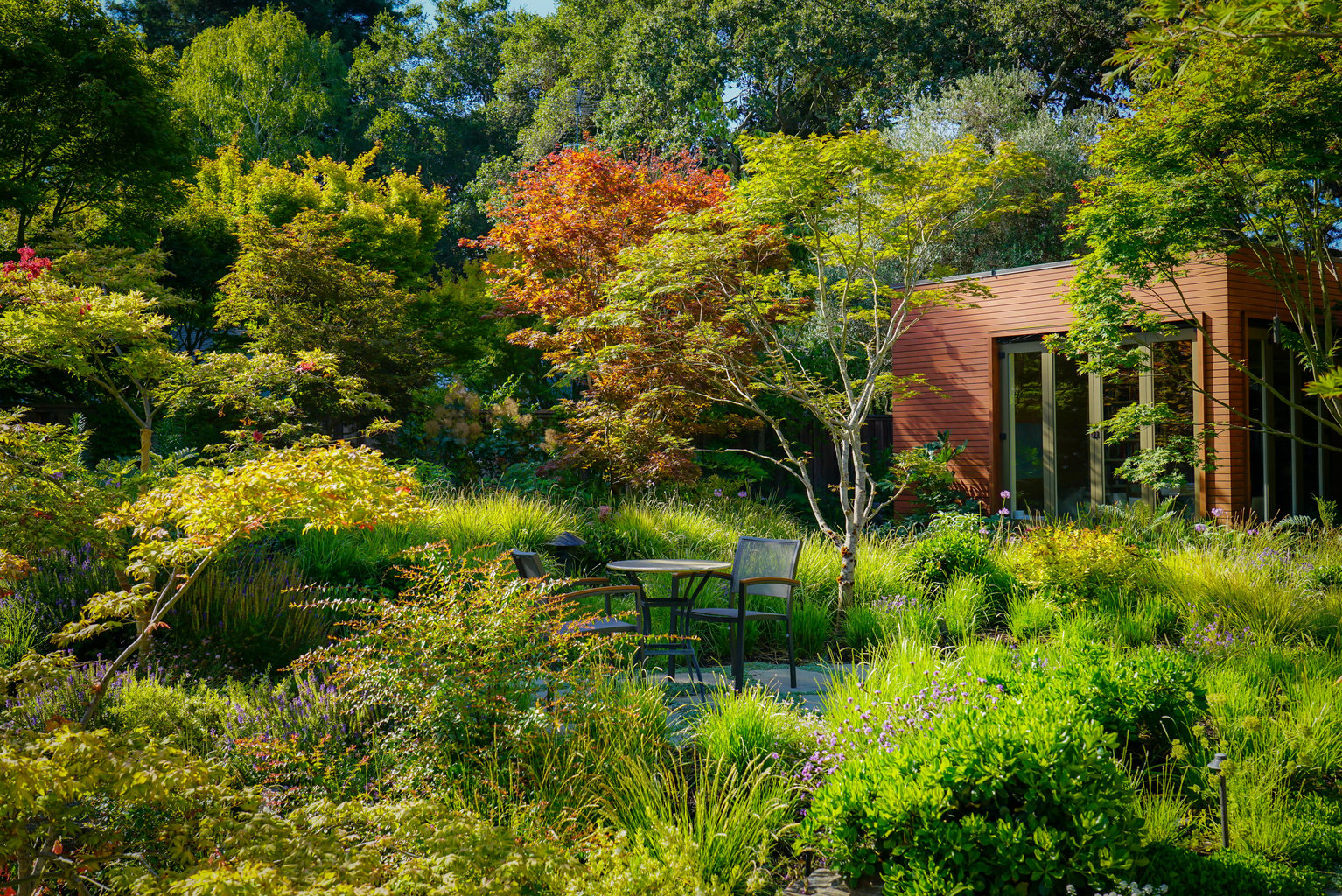

Contributor
- Topics: Archive

Imagine a landscape ablaze with wildflowers, graced by swaying grasses, and filled with butterflies, birds, and beneficial insects. Who wouldn’t want such a lively, colorful scene in their own garden? No wonder such meadow gardens continue to grow in popularity. They appeal to that streak of independence and wildness within us and remind us of the beauty of wide-open spaces.

Botanically speaking, the word “meadow” is sometimes used interchangeably with “grassland” or “prairie,” and a meadow is, in fact, a kind of grassland. Typically devoid of trees and shrubs, grasslands are characterized by an open expanse of grasses, sedges, annual and perennial wildflowers, and bulbs. In California, many botanists restrict the term “meadow” to high-elevation plant communities that stay fairly moist throughout the summer growing season; in Reimagining the California Lawn, meadows are more broadly defined to encompass grasslands in general.
For the gardener, an important feature of a meadow garden—unlike a greensward—is that it includes herbaceous perennials, annuals, or bulbs along with the grasses and sedges. Since many meadow plants will not tolerate regular foot traffic, a greensward is a better choice for spaces that will see more intensive activities, such as outdoor play. But if you do not need a garden with the resilience of turf, a meadow offers one of the most alluring options for lawn replacement.

History and Examples
Similar to greenswards, the earliest meadow gardens were precursors to today’s lawns. These flowery meads included grasses and other plants and were created by transplanting patches of sod from natural meadows into the private gardens of wealthy landowners. Grazing sheep and manual scything were used to help keep the mead about six inches tall. Over time, the loosely maintained style of meadow lost favor, and the meadow garden was replaced by the more manicured greens that we know today as lawns.
By the early 1900s, some landscape designers began to rebel against the formal treatment of gardens. Prominent among them was Jens Jensen, a Danish immigrant who became a respected landscape designer in the United States. Jensen advocated a return to a naturalistic approach in landscape and became a vocal proponent of preserving and protecting Midwestern prairies. His efforts, and those of other conservationists awakened an interest in the use of grasses as ornamentals. It was not until the 1960s, however, that grasses began to enjoy widespread appreciation for their ornamental value. Nurserymen Karl Foerster in Germany and Kurt Bluemel in the United States championed the use of grasses; their advocacy helped inspire the designs of James van Sweden and Wolfgang Oehme, who pioneered the “New American Garden,” a visionary approach that embraced our vanishing grasslands. This style brought undulating drifts of bunchgrasses and herbaceous perennials into public spaces. Finally, grasses were “in,” at least on the East Coast and in the Midwest. It took several more years for this idea to catch on out West. Today, grasses are now commonplace in California’s landscapes, but their use in naturalistic meadows or grasslands in public spaces is still relatively scarce compared to residential installations.
A few excellent public examples of native meadow gardens are well worth visiting. Perhaps the most well known is the meadow at the Santa Barbara Botanic Garden. Today, this constantly evolving one-acre tableau features a rich tapestry of native grasses and wildflowers. The award-winning native garden at the San Francisco Botanical Garden is a lovely assemblage of both wet and dry meadows framed by a shrubby border. In Berkeley, the Regional Parks Botanic Garden offers several displays that replicate native grasslands from around the state.
Native grasslands and meadows once covered huge swaths of the state, but are now greatly diminished due to encroachment by agriculture, grazing, urbanization, and the invasion of exotic species. However, gardeners seeking to create their own personal meadow can still find numerous examples on public lands from which to draw ideas and inspiration. The UC Davis Jepson Prairie Reserve in Solano County offers spring wildflower displays and a large variety of native grasses. For moist montane meadows, Tuolumne Meadows in Yosemite National Park is a much-loved site known for its array of sedges and delicate wildflowers. Point Reyes National Seashore is home to coastal prairies that include plants such as tufted hair grass and Douglas iris. Extensive serpentine grasslands at the Blue Ridge Lake Berryessa Natural Area in the North Coast ranges provide intriguing examples of grasses and wildflowers that thrive in harsh, dry situations.

Design and Installation
From a design standpoint, meadows are, by definition, naturalistic and informal. The commingling of grasses and wildflowers—the very essence of a meadow—does not lend itself to routine mowing, shearing, and deadheading. Indeed, a major appeal of the meadow garden is vibrant change throughout the seasons— from young green or silvery shoots to elongating wandlike stems and unfolding blossoms and finally to ripening seed heads and subtle autumnal colors. The buzz and hum of wildlife and the motion of wind-tossed grasses are other dynamic elements of the meadow that make this type of landscape so enticing.
In nature, meadows are incredibly complex ecosystems; their assemblages of wildflowers and grasses are often tightly knitted together, and individuals are hard to discern. Similarly, the composition of the meadow garden is best treated as a whole, in contrast to the way you would maintain the distinct plantings of a perennial border. If you are comfortable with the aesthetic of some plants in bloom while others are dormant, you can enjoy these seasonal changes and plan to cut everything back all at once. Keep in mind that a meadow garden with greater plant diversity is usually more complicated to maintain. If one of your goals is to have a lower-maintenance landscape, avoid the temptation to use too many species in your meadow garden.

Whether complex or simple, meadows offer a more visually interesting composition than traditional lawns. Their seemingly random patterns and naturalistic appearance are well suited to rural or informal settings. For properties that border native habitats, meadows make an excellent bridge between formal gardens and adjacent wild areas. Meadows are equally striking when partnered with modern architecture, providing contrast to the bold lines and dramatic forms typical of contemporary structures. In fact, a well-designed meadow will complement any architectural style.
The first step in planning a meadow garden is deciding whether you want a meadow with both tall and short plants or one that is more lawnlike and composed of lower-stature plants. Next, decide whether you want the meadow to be green or brown in summer. If you wish to replicate the natural cycle of our mediterranean climate’s moist winters and dry summers, choose cool-season grasses, such as nodding needlegrass or tufted hair grass; these grow during the cooler months and enter dormancy when the soil begins to dry out in summer. Although you can stretch their growth period with some judicious supplemental irrigation, most cool-season grasses perform best when allowed to rest during the hot summer months. A few summer-blooming wildflowers, such as California fuchsias, buckwheats, or goldenrod, will add vibrant color and complement the silvers and tans of the drying grasses. If your meadow is going to feature warm-season grasses, several good choices include grama grass, deer grass, and dropseed. As with any kind of garden, settling upon a color scheme will help to further refine your plant palette.
Spend time thinking about the overall shape of your meadow garden and how it will be viewed. The fine textures of many grasses and wildflowers are enhanced when framed by a backdrop of bolder woody plants, a fence, or a wall. Also consider how you will move through the garden, since meadows are meant to be walked through, rather than walked upon. Paths can be constructed of non-living materials such as gravel, flagstone pavers, mulch, or bare earth. For a softer effect, and where foot traffic will be minimal, consider planting the pathways with tough, low-growing species that need little to no mowing, such as grasses, sedges, common yarrow, or silver carpet. Your meadow garden will benefit from the careful placement of a focal point such as a favorite shrub, a bench, or a piece of sculpture to bring visual weight to the composition year-round.
Meadow gardens can be installed in one of several ways: by seeds, plugs, larger container-grown plants, or a combination of all three. Your budget and time frame will influence which method to select. Starting a meadow exclusively from seed eliminates the labor of planting individual pots but will require more vigilant weed control and watering during the germination phase. Planting from plugs is less expensive than using plants from four-inch or one-gallon containers, but the smaller root systems of plugs dry out more quickly during the days and weeks immediately after planting. Using larger plants initially costs more, but this strategy also produces a more instant landscape. Seeding rates, spacing of container-grown plants, and irrigation methods are all dependent upon the species used. With seeds and plugs, avoid the inclination to sow or plant annual wildflowers in the first year as the latter can quickly out-compete young grasses. Regardless of method, cool-season grasses and wildflowers are best seeded or planted in fall or early winter, whereas warm-season species perform better when set out in spring.

red fescue
Maintenance and Special Issues
Even with thoughtful planning, implementation, and initial care, the maintenance demands of a meadow garden can be considerable. Weed management is crucial during the early development stages, even if the site was previously landscaped with a relatively weed-free lawn. Nearby gardens, seed packets, and container-grown plants may harbor weedy grasses and forbs that will invariably find their way into your new meadow. Learning to distinguish between desirable seedlings versus weedy ones will be critical to the successful establishment of your meadow.
A meadow garden can be designed to thrive on natural rainfall. Supplemental irrigation should only be necessary when dry spells occur during the rainy season. In most climate zones of California, an occasional deep watering of your meadow during dry summer months may prolong its flowering and extend the growing season beyond the normal cycle.
Annual mowing or pruning of the meadow in late summer or fall accomplishes several tasks at once: it removes dead flower stalks and dried leaves; rejuvenates grasses, sedges, and perennial herbs; and reduces the fire hazard posed by seasonally dry vegetation. Be sure to wait until some seeds have ripened before cutting plants back if you want to encourage a new crop of seedlings next year and visits from the many songbirds and small mammals that feast on these seeds.
Share:
Social Media
Garden Futurist Podcast
Most Popular
Videos
Topics
Related Posts

Low Maintenance Gardens – Better for Pollinators and People
Autumn 2022 “I come out every day. It’s therapy, my meditation.” Janet’s young garden transformed from overgrown, invasive plants to mostly natives. The dailiness of

Invasive Plants Are Still Being Sold: Preventing Noxious Weeds in Your Landscape
Autumn 2022 With so many beautiful ornamental plant species and cultivars throughout California and the Pacific Northwest, how do you decide which ones to include

Garden Design in Steppe with Transforming Landscapes with Garden Futurist Emmanuel Didier
Summer 2022 Listen to full Garden Futurist: Episode XVII podcast here. Emmanuel Didier, Principal and Creative Director at Didier Design Studio is a leading figure

Seslerias: Versatile Groundcover Meadow Grasses
Summer 2022 Without question, the most beautiful and versatile of all the groundcover meadow grasses are the moor grasses (Sesleria). Moor grasses tick off all









